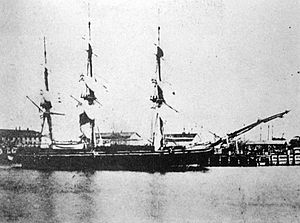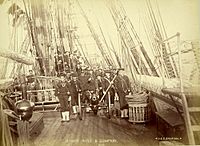USS Saratoga (1842) facts for kids

USS Saratoga (known in Japan as one of Perry's Black Ships)
|
|
Quick facts for kids History |
|
|---|---|
| Name | USS Saratoga |
| Namesake | Battle of Saratoga, 1777 |
| Builder | Portsmouth Navy Yard, Kittery, Maine |
| Laid down | 1841 |
| Launched | 26 July 1842 |
| Commissioned | 4 January 1843 |
| Decommissioned | 10 December 1844 |
| Recommissioned | 15 March 1845 |
| Decommissioned | 7 January 1847 |
| Recommissioned | early 1847 |
| Decommissioned | 26 February 1848 |
| Recommissioned | 10 April 1848 |
| Decommissioned | 30 November 1849 |
| Recommissioned | 12 August 1850 |
| Decommissioned | 10 October 1854 |
| Recommissioned | 6 September 1855 |
| Decommissioned | early 1858 |
| Recommissioned | early 1858 |
| Decommissioned | 26 June 1860 |
| Recommissioned | 5 November 1860 |
| Decommissioned | 25 August 1861 |
| Recommissioned | 24 June 1863 |
| Decommissioned | 28 April 1865 |
| Recommissioned | 1 October 1867 |
| Decommissioned | 7 July 1869 |
| Recommissioned | 16 May 1871 |
| Decommissioned | 14 October 1871 |
| Recommissioned | 1 May 1875 |
| Decommissioned | 7 May 1876 |
| Recommissioned | 19 May 1877 |
| Decommissioned | 8 October 1888 |
| Fate | Loaned to Commonwealth of Pennsylvania for use as maritime school ship 1890–1907; Sold for scrapping 4 August 1907 |
| General characteristics | |
| Type | Sloop-of-war |
| Tonnage | 882 |
| Length | 146 ft 4 in (44.60 m) |
| Beam | 35 ft 3 in (10.74 m) |
| Draft | 16 ft 3.5 in (4.966 m) |
| Propulsion | Sail |
| Complement | 210 officers and men |
| Armament |
|
| Notes |
|
The USS Saratoga was a sailing warship, called a sloop-of-war, that served the United States Navy for many years in the 1800s. It was named after the Battle of Saratoga from the American Revolutionary War. The ship was built at the Portsmouth Naval Shipyard in Maine. Its construction began in 1841, and it was launched on July 26, 1842. The Saratoga officially joined the Navy on January 4, 1843, with Commander Josiah Tattnall III in charge.
Contents
Early Missions and Service
Protecting American Interests in Africa
The Saratoga began its first journey from Portsmouth, New Hampshire, in March 1843. After some repairs due to a storm, it sailed to New York Harbor. There, Commodore Matthew C. Perry joined the ship, making it the flagship for the Africa Squadron.
The ship's main job was to patrol the coast of West Africa. It protected American citizens and trade. It also worked to stop the illegal slave trade. The Saratoga often visited the Cape Verde Islands for supplies and rest.
A big part of the Saratoga's work involved supporting Liberia. This colony was founded for freed African Americans. However, local tribes who had profited from the slave trade often caused trouble for the colonists. They sometimes attacked American merchant ships too.
Commodore Perry had to balance protecting American interests with not getting too involved in local African conflicts. He also wanted to help the Liberian colonists.
Dealing with Coastal Conflicts
In late 1843, the squadron returned to Liberia. They heard that tribes were causing problems in Sinoe and had killed two sailors from an American ship, the Edward Burley. The Saratoga and other warships gathered at Sinoe. Commodore Perry and Liberian Governor Joseph Jenkins Roberts met with tribal kings.
After hearing all sides, Perry decided that while the American sailors' deaths were wrong, the Americans had started the conflict. He explained that the U.S. wanted to be friends with all tribes but would protect American lives and property. He then let the Liberian colonists, with help from friendly tribes, push the troublemakers away.
Later, the squadron went to Little Berebee to investigate the attack on another ship, the Mary Carver, where the entire crew was killed. During a meeting, a native fired a gun at the American group. Commander Tattnall of the Saratoga shot and killed one of the attackers. This showed that the U.S. was serious about keeping peace and protecting its people.
After these events, the Saratoga continued its patrols. It sailed along the coast to the Bight of Biafra. Many sailors got yellow fever that summer. The ship returned to the U.S. in November 1844 and was taken out of service.
Key Conflicts and Contributions
Serving in the Mexican-American War
The Saratoga was put back into service in March 1845. It was sent to the Gulf of Mexico because of growing tensions between the United States and Mexico over Texas. The ship helped protect American interests in the Gulf.
Later, it was ordered to the Pacific Ocean to join a squadron off the California coast. However, after sailing around Cape Horn, the ship was badly damaged in a storm. It had to return home, reaching Hampton Roads in December 1846. The ship was taken out of service again in January 1847 for repairs.
After repairs, the Saratoga was recommissioned in 1847 with Commander David Farragut in command. It joined the Home Squadron off Veracruz, Mexico. The ship helped blockade the port of Tuxpan and carried important messages. Many sailors on board suffered from yellow fever during this time. The Saratoga returned to New York City in February 1848 and was decommissioned. It was recommissioned briefly in 1848-1849 for duty in the Caribbean Sea before being decommissioned again.
Opening Japan to the World
The Saratoga was recommissioned in August 1850 and sent to the western Pacific. A major event during this time was its role in Commodore Perry's mission to open Japan. In July 1853, the Saratoga visited Japan with Perry's fleet. After this visit, it sailed to China to protect American interests in Shanghai while Japanese officials thought about Perry's proposals.
The Saratoga returned to Japan with Perry in February 1854. After a treaty was signed between the U.S. and Japan in March, the ship carried a copy of the treaty to the Hawaiian Islands. It then sailed around Cape Horn and returned to Boston, Massachusetts, in September 1854, where it was decommissioned.
Ending the Reform War
The ship was put back into service in September 1855. It sailed in the Caribbean Sea and the Gulf of Mexico. In 1860, the Saratoga took part in a naval battle off Anton Lizardo, Veracruz. The Saratoga and two other ships defeated two Mexican vessels. This battle helped bring an end to the Reform War in Mexico.
Stopping the Slave Trade
In November 1860, the Saratoga returned to the west coast of Africa. On April 21, 1861, it captured a slave ship called the Nightingale off Cabinda. The Nightingale was carrying many enslaved people, who were then freed.
When news of the American Civil War reached the Saratoga, it returned to the United States. It was decommissioned in Philadelphia in August 1861.
Role in the American Civil War
The Saratoga was recommissioned in June 1863. It was assigned to guard the Delaware Bay, protecting Union ships. In January 1864, it joined the South Atlantic Blockading Squadron. This squadron blocked Southern ports to prevent supplies from reaching the Confederacy.
During its service off the Atlantic coast, landing parties from the Saratoga conducted several raids. These raids captured prisoners and destroyed military supplies, ammunition, and other resources. They also destroyed buildings, bridges, and salt works.
As the Civil War ended, the Saratoga was taken out of service in April 1865. For the next ten years, the ship mostly rested, with only two short periods of active duty for coastal operations.
Later Years and Legacy
A Training Ship for Future Sailors
The Saratoga was reactivated in May 1875 for a year as a gunnery training ship in Annapolis, Maryland. After another year of rest, it was recommissioned for its final role in May 1877. For over eleven years, it served as a school ship, training young naval apprentices.
This duty took the Saratoga to various naval bases along the Atlantic coast and sometimes to Europe. During this time, three of its crew members earned the Medal of Honor for saving fellow sailors from drowning. These brave acts happened in New York Harbor in 1879 and off Rhode Island in 1881. The Saratoga was finally decommissioned on October 8, 1888.
From 1890 to 1907, the ship was loaned to the state of Pennsylvania. It served as a state marine school ship for the Pennsylvania Nautical School in Philadelphia. The Saratoga was sold for scrap on August 14, 1907. In 1908, it was burned as a public attraction for tourists at Revere Beach.
Images for kids
See also
 In Spanish: USS Saratoga (1842) para niños
In Spanish: USS Saratoga (1842) para niños








